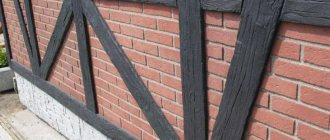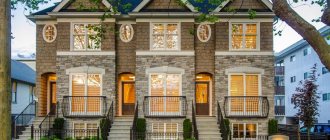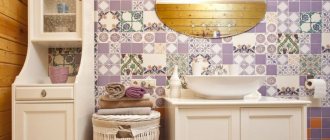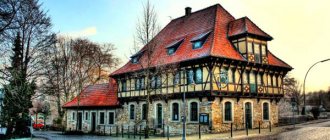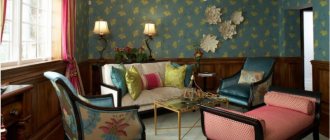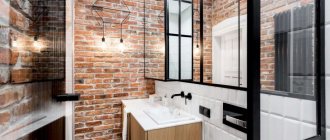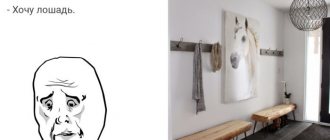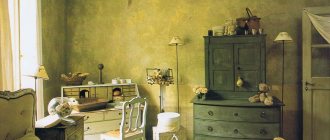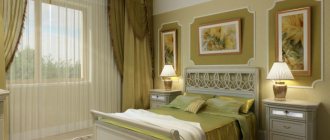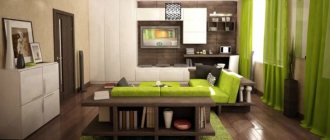Architectural styles typical of Western countries are now very popular among domestic developers. In elite Russian villages, you can increasingly see houses stylized as French Provence, English classics, luxurious baroque or ultra-fashionable high-tech. But ordinary homeowners are especially fond of the German style, characterized by a combination of restraint and comfort.
German style house
German style house facade
What insulation materials are used in wet facade systems
Glass wool and mineral wool are strictly prohibited. This is due to the insufficient strength of these insulation materials. They are not able to withstand the weight of plaster. Because of this, they are prone to delamination. Polystyrene foam is also not included in the thermal insulation used.
Typical insulation materials for wet facades are polystyrene foam and basalt wool
The wet façade insulation system involves the use of basalt wool or expanded polystyrene as insulation. Comparing them with each other, the choice is not in favor of the latter. This is due to the fact that polystyrene foam does not allow air to pass through at all. With such insulation, a wet facade for a wooden house will be destructive. The walls of a building insulated with this material will be damp and susceptible to the harmful effects of moisture, parasites and rot.
Features of a German-style house
The Bavarian or German style of the house presupposes neatness and even some asceticism in the external design. Its characteristic features include:
- lack of lush decorative elements;
- strictness of lines;
- practicality;
- use of inexpensive materials in finishing;
- calm color scheme.
Every element of the house must comply with these rules. Despite its apparent simplicity, while respecting the traditions of Western European architecture, the building does not look inconspicuous. Country cottages in the German style resemble fairy-tale houses straight from the pages of fairy tales. This effect is enhanced by the neat design of the local area - trimmed lawns, decorative plantings near the porch, hedges.
Walls and roof
When it comes to traditional German house style, the most common building shape is a rectangle or square. The walls are made smooth and painted in discreet colors - white, sand, gray. The combination of dark wood (timber) and clay is popular; the façade can also be decorated with polymer panels, cement-bonded particle boards or brick. The base is often finished with natural stone.
The roof of a Bavarian-style house is usually gable, without an attic and with wide overhangs. Acceptable colors include red, brown, green, blue shades and their variations. Sometimes several similar tones are combined in one coating.
The roofing material is tiles or natural slate (slate). If the house is two-story, there may be an attic under the roof with a fence made of tinted wood, a bay window or a balcony.
Windows and doors
The entrance lobby and windows, decorated in German style, should attract attention. The door itself is usually wooden, with glazing and lintels in the upper part.
A porch, wooden or stone, leads to the entrance to the building. There can also be a spacious veranda in front of the door.
Windows are usually rectangular or arched in shape. Each of them consists of several square or rectangular sections connected by jumpers. Modern Bavarian style also allows for panoramic glazing of houses.
If this is combined with the overall style of the facade, the windows can be complemented with shutters. They perform decorative functions, creating a bright accent and giving the house a rustic, cozy look. Sometimes shutters are covered with carvings and paintings.
Main details
In order for your house or cottage to be decorated in a German style, the façade of the building should look as similar as possible to the original building. To do this, you need to study the main important details of such decor:
Taking into account the listed details, finishing the facade in the German style will not cost much. The largest amount of costs falls on the purchase of wooden parts and paint necessary to decorate the main area of the walls. The work ahead is mostly simple, which even a beginner in such matters can handle.
German technology of half-timbered houses
Many sources attribute the creation of this technology to the Germans. It is generally accepted that the first building, where a wooden frame in the form of beams connected at different angles and visible from the outside of the house, was built in the city of Quedlinburg in 1347. Since then, so-called “frame” houses have spread throughout Europe. They became especially popular in Germany, France, and Poland. The reason for the popularity of such buildings is quite simple - cost. Since wood is a fairly expensive material and building an entire house from solid wood is expensive and not practical, it became most rational to use frames, and clay with straw or brick was used to fill the space between the beams. Nowadays, technology has not disappeared, it has changed a little. It is customary to use not solid wood as a frame, but laminated veneer lumber, and to fill the gaps in the frame, concrete and brick are used, but glass is probably considered the most fashionable and sophisticated material today.
Traditional furniture
Furniture in the Bavarian style has a number of distinctive features:
- The main material from which most of the furniture in any room of the house should be made is natural wood.
- All furniture should be smooth, without sharp corners.
- The main decor of wooden furniture is carving.
- Artistic painting as decoration is also acceptable.
- It is ideal when the legs of the furniture are unusual, made in the shape of animal paws.
- All upholstered furniture in the living room should be upholstered in expensive fabric, such as velvet.
- A mandatory attribute of a bedroom is a spacious wardrobe.
- Cabinets with glass elements will also find their place in the interior. They will be placed in the living room or dining room to display beautiful dishes, festive dishes, and painted mugs.
To find suitable furniture, it is best to go to antique shops and find real items brought from Bavaria. Of course, such furniture will cost a pretty penny. If you want to save a little money, buy imitation Bavarian furniture at a regular furniture store.
Gothic houses
Gothic style in Germany began to develop in the 10th-11th centuries under the influence of French architecture. German buildings had their own characteristics - strict geometric shapes (usually a rectangle), one or four high towers instead of two, more modest facade decoration, external resemblance to defensive fortresses.
The building material is usually brick or stone. The height of the building is at least 3 floors, the roof is pointed, the windows are pointed and elongated. The roof of German Gothic houses is distinguished by color; any contrasting combinations are possible - dark tiles and light walls, or vice versa.
Although this style may seem outdated, it is still popular, including in cottage construction. A country house in the Gothic style is a personal fortress that exudes reliability and antiquity. It will look especially organic in the lap of nature - in mountainous areas or on the edge of a forest.
A house in the Bavarian style, be it a rustic, cozy half-timbered cottage or a sophisticated Gothic fortress, is an example of German quality and practicality. You can be sure that buildings built using technologies proven in Germany will serve more than one generation of owners and will be able to surprise guests with their unusual design.
Interior decoration
Inside, wood, stone, metal, and glass are used for decoration. Wall surfaces are plastered, painted or wallpapered. There are beams on the ceiling; after whitewashing, it is not forbidden to apply gilded relief figures or paintings to it. A fireplace and forging elements are required.
Modern trends require minimalism in furnishings that do not overload the space. The furniture upholstery is made of chocolate, dark green, and burgundy fabric.
The living room has spectacular furniture with a sofa and pillows, armchairs, and a table covered with a tablecloth. A large role is given to low massive chandeliers, candelabra and candlesticks. Priority is given to chests with metal parts, carvings or stucco. The bedroom has a large canopy bed. There is a feeling of wealth, nobility and power in everything.
The multifunctional kitchen is characterized by immaculate cleanliness and polished metal utensils. For Gothic style, expensive brocade and velvet textiles are required, otherwise textiles in pastel shades made of linen and cotton. The combination of dark and light tones gives the atmosphere drama and severity.
Plaster as a type of material for facade finishing
If you are looking for a budget option to transform your home, then use decorative bark beetle plaster or pebble plaster - these are the most common types of building materials for facade finishing work.
Many people prefer this type of decoration, due to the versatility of plaster and its features, which can be listed:
- a wide palette of colors, that is, there are no restrictions on color, the plaster can be painted in absolutely any color;
- low cost of materials;
- The help of specialists is not required; the work can be done independently.
Both “bark beetle” and pebble plaster do not differ in application techniques. The only difference is in the structure of the finished product. Finishing the facade with bark beetle plaster has the appearance of small depressions - pits, which become clogged with dirt over time. This problem does not arise when working with pebble plaster.
Natural and artificial stone is not the last word in facing works
Perhaps the most expensive and most painstaking work is facing the house with stone. If you are a supporter of the Gothic or classical style, then this material is just for you.
Among the owners of private houses, you can find those who use clinker tiles that imitate brick. In appearance, walls lined with such tiles are no different from walls made of brick.
Some multi-storey buildings are decorated by city and municipal authorities with multi-colored tiles. Such a house looks bright, cheerful and stands out against the background of gray city buildings.
As you can see, the field for activity is huge. The construction market can offer different classic and modern types of facade finishing. It all depends on your taste.
Classic is always in fashion
The classic façade has been in demand for many years and is applied to different types of buildings. “Classicism” translated from Latin means “sample”, and the classical facades of the century before last were considered the standard style of a Russian estate. The combination of design with landscape is the main principle of noble classicism.
The modern master knows how to decorate and ennoble the facades of a classic with its stone carvings and charming sculptures. Facade stucco is often used as decoration. By choosing this style, the owner will not go wrong: light, practical materials will fit perfectly into the environment, and at the same time the house will attract attention with its sophistication and beauty.
Classic house facades have distinctive features:
- “white stone” columns;
- natural stone: travertine, marble and granite;
- balustrades and cornices;
- parapets and bas-reliefs.
Stone is the main element when finishing facades in a classic style. Stone, due to its high cost, is often replaced with stone-look products. You can imitate stone with products made of polystyrene foam, and also use various panels. The plaster facade is sometimes disguised as stone.
Stylistic features
Now we can talk about stylistic features. Form
at home is as close to a square as possible. That is, the width and height are equal or almost equal. The foundation is quite high; it is customary to clad it and the ground floor with stone or imitate this cladding. The reason for this is not only beauty criteria. Bavaria and Saxony are prone to flooding. A German-style house must withstand the onslaught of the elements. In Bavaria they like to raise the stonework right up to the roof in the corners, and even in the center of the façade.
The walls themselves
plastered and painted almost everywhere in light colors.
Almost always in shades of milk, less often in pale pastels. As you have already noticed, the facade
is necessarily covered with wood.
It could be just a simple lattice, or it could be a real work of art. The wooden parts are always dark, this, and the stonework underneath makes them look similar to each other. And everything would be like in the army, but! The Germans love to decorate their houses with protruding elements - balconies and bay windows
. Bay windows and balconies are always different, they are like a highlight, like a decoration. They are what make the houses individual and unique.
In the right corner of the photo, where there are bay windows and balconies, we have the rare happiness of seeing a fragment of an old, old house. Now he is completely different... Roofs
The houses are complex, multi-sloped, with attics and attics. Often an entire apartment fits under the roof itself. Previously, they were covered with fabulously beautiful real ceramic tiles. Today, almost all of it has been replaced with metal tiles. And almost always traditional terracotta colors.
The entrance to the house is always organized by a small staircase
- five to seven steps, a wooden door with windows and a canopy over it.
Entrance doors are indeed quite fragile everywhere. I have not seen iron or armored ones anywhere. The windows
are rectangular, with a 2/3 proportion, or arched. Partitions traditionally divide a window into six parts. Practical Germans today have replaced almost all traditional ones with plastic ones, with white or still brown frames.
Understand the Germans' love for plants
almost impossible. It’s a strange kind of love, but many people like such clarity. Yes, yes, almost always, almost everywhere - red flowers. And in Austria it’s the same. It is not possible to find out exactly why this is so; the secrets are kept under an iron lock. And why bother digging when all the details together create an incredibly calm, cozy atmosphere!
How to do everything
You should start by purchasing the necessary paints, antiseptics and wood. When everything you need is prepared, you can move on to the main part of the work. To get a façade in the German version, as in the photo below, you just need to follow the simple instructions:
Tip: Having chosen the appropriate option for placing all the details, you can apply an approximate diagram to a printed photo of your building and immediately see the result.
Decorating the facade of your country house or country house in the German style is easy and inexpensive. That is why this repair option is very suitable for country houses - here it is customary to save on finishing and, as a rule, all finishing is ordinary painted lining.
Source
External finishing of facades with stone
The owners of this house believe that it is better to clad the house with natural stone.
Natural stone is one of the most durable building materials. Exterior decoration made from it, if not eternal, will definitely serve for several centuries. However, laying fragments of natural stone, especially wild, natural stone, requires considerable effort and special skills.
This is what finishing from different types of granite looks like
And this is what limestone cut into tiles looks like on the façade:
Marble is used less frequently for facade cladding, as it is less resistant to moisture and temperature changes than, for example, granite. However, if you want to turn your home into a real glittering palace, you can use, at least partially, marble finishing.
An intermediate option between limestone and marble is travertine:
And this is a more budget “version” of travertine - Dagestan stone:
Porous shell rock of a warm sand color is also perfect as a facing material:
Over time, its shade becomes darker, but to avoid this, you can coat the surface with a protective varnish. If you are against using natural stone, you can clad your house with artificial tiles that replicate the texture of natural material:
Another option is an easy-to-install artificial flexible stone, which is acrylic slabs with an adhesive base:
How to decorate a facade in the German style on your own
Among all architectural trends, much attention is drawn to the German style, which is often used in modern construction when finishing the façade parts of a mansion. This style is characterized by restraint and elegance, uncomplicated lines
Looking at such a facade, there is an unfeigned feeling of the monumentality of the structure and homely warmth. The main advantage of the German style is considered to be that it can actually be formed both during the construction of the facility and upon completion of construction. In full agreement with the sayings about German thrift, creating a facade in the German style will be relatively economical and will not require too much money. The German style can be noted as quite economical, but at the same time it is known for its expediency and originality of decoration.
Its decorative elements are distinguished by their simplicity and conciseness. The German style should not contain bright colors, sculptures, intricate decorations and patterns. The main trend will be expediency. The color range of the German style is also quite small.
How to make a facade in the German style.
How to decorate a wall and roof in a German style? The shape of the building must be classic - square or rectangular. However, protruding parts that make the living space larger are also permissible. The texture of German-style walls should be smooth. Regarding the roof, it is often built with a gable roof, the recommended colors are brown. If you want to display the German style on the facade of your mansion as accurately as possible, then it is advisable to lay tiles on the roof. The base is decorated using natural stone. German-style attics are rarely created. A more common option are small balconies. By taking these technological nuances into account, you have the opportunity to add a sophisticated and impressive look to the façade of your home.
Installation of windows and doors. The demands in this segment are very considerable. First of all, you need to know that the German-style front door is the “highlight” of the facade
She must attract attention and be conspicuous against the general background. Windows in this style are traditionally rectangular, but can sometimes be arched
In addition, a distinctive feature will be the creation of multi-section windows, when the glass is separated from each other by numerous jumpers. To top it off, the windows are equipped with wooden shutters, which serve a purely decorative purpose, giving the mansion a lived-in and sleek appearance.
Types of house facades: Gothic house and half-timbered house.
Half-timbered houses. Half-timbered architecture is a famous style of architecture in Germany. A distinctive feature of these buildings is the creation of a vertical frame with transverse beams and diagonal braces. Curly beam structures are also typical for it. To make the building more expressive, the beams are painted in tones that contrast with the colors of the walls. Curved beams in combination with natural stone cladding or plaster look especially aesthetically pleasing on walls.
Gothic houses. Buildings decorated in Gothic style always stand out for their originality. In the photographs, these mansions look like true medieval castles. This is facilitated by the cone-shaped roof and vertically elongated windows, which visually make the entire building taller and more impressive. Stone columns complete the appearance of the Gothic mansion. They are required not only for decoration, but also have a practical function - they support the roof of the veranda.
By decorating the facade in the German style, you get the opportunity to get a truly excellent effect, which will make your house stand out from its neighbors.
Previous post Next post
Color spectrum
When styling for this solution, it is important not to make a mistake with the color scheme. The following shades are most often used in the decoration of facades and interiors:
- beige;
- white;
- sand;
- creamy;
- terracotta;
- olive
Carved furniture in German style
Lighter ones act as background ones, and darker ones are used to place accents. Doors or window shutters can be bright. And even here there should not be aggressive, but calm blue, red, green colors.
Bedroom interior in German style
If you are making a two-story Bavarian house on your summer cottage, do not forget to install wooden frame structures along the walls. To decorate a simple architecture, the frame should be painted in a dark color that will contrast against the white facade. The most popular roofing material is tiles. It is usually either red-brown or dark gray. Choose the most comfortable and acceptable color for yourself.
Classic interior in German style
Useful tips for masters
Half-timbered facade (drawing)
Here are some more recommendations for individual developers:
- Fachwerk finishing is used only on low-rise buildings.
- The width of the elements simulating the load-bearing frame of a house should be no narrower than 150 mm.
- The minimum distance between posts is 60 cm (2 feet).
- The frame posts of half-timbered buildings can be installed flush with the facade or protrude from the wall. Decorative false beams are also attached using the same principle.
- The visual separation of the first and second floors is emphasized by two or three rows of horizontal beams.
- Window frames must have small frames.
- Doors for the façade under half-timbered structures are solid, massive, without glazing.
- An excessive or insufficient number of dark beams placed on a light wall will create an imbalance in the overall picture of the style.
- Drainpipes and other technical elements of the building should be brought into line with the design of the facade.
- The foundation of the house is covered with natural stone.
- The half-timbered style is characterized by the use of decorative details: figured ornaments on the heads of beams, carvings on corner posts.
The plastered surface can be decorated with coats of arms and plant designs. In the tradition of half-timbering, outline the frame parts on the plaster with a thick black line so that the beams seem more reliable and massive. If brick is used to fill gaps, it is laid out in repeating geometric patterns.
Finally. A house with a half-timbered facade looks original and presentable
Such a cottage definitely attracts the attention of investors. It is easy to sell, having essentially invested not so much money in upgrading the façade
The half-timbered architecture distinguishes the building from the general range of standard buildings, emphasizes the artistic taste and a certain status of its owner.
Situation
The interior decoration, or interior of a half-timbered house, is selected taking into account the characteristics of the style - laconicism, simplicity, minimalism, the predominance of horizontal lines. Narrow, elongated hanging furnishings and squat sofas leave room for a feeling of freedom. The color scheme is dominated by non-bright, light, pastel tones.
Fachwerk has a great future, without any doubt. Thanks to environmental friendliness, stylishness, reliability, lightness and short lead times.
Imitation in half-timbered style
Half-timbered polyurethane
The house, which will be finished in the half-timbered style, can be cinder block, brick or wood. Polyurethane is most often used as the main material. It is used to make beams and boards, which are extremely difficult to distinguish from natural wood even at a short distance. This material is resistant to moisture, mold, precipitation and insects. It is not deformable and does not crack. And the cost of polyurethane beams is much lower than that of their natural wood counterparts.
Decorating the façade of a house with half-timbered timber is an excellent solution! Polyurethane boards are installed using liquid nails. Before you buy glue, take a look at the instructions
It is very important that liquid nails are suitable for outdoor work. After all, the glue must be resistant to temperature changes and precipitation
A miter saw or circular saw should be used to fit joints and make clean cuts. If you decide to fill the frame with DSP, then the slabs can be easily cut with a jigsaw or grinder. Paint the cut pieces with water-soluble or oil paints. After the DSP has dried, they can be screwed to the beams, filling the space between them. A house that is covered with panels is warmer and has improved sound insulation of the walls. This technology is excellent for cladding houses made of bricks and blocks that are very worn out. An example of such half-timbered houses can be seen in the photo.
Light plaster and dark beams
If you decide to make a half-timbered house yourself, then first plaster all the walls. After they have completely set, paint the walls in some light tone. To do this, use acrylic emulsion. False beams should have a contrasting color, such as brown or black. Today you can purchase a composition in a specialized store that gives the board a patina effect.
If you decide to use natural boards as false beams, then treat them with antiseptics, and then paint them on both sides, including the ends.
History of half-timbering
The German word Fachwerk is formed from two parts: das Fach - section, cell and das Werk - structure. Literally it turns out to be “a structure made of sections.” Looking from the side at half-timbered houses, we will be convinced of the accuracy of the definition. Similar to gingerbread houses from a fairy tale, they will not go unnoticed while walking along the ancient European streets. Their invariably light walls seem to be “cut” by dark wooden beams. The structure is completed by a sloping roof.
Half-timbered houses
According to historians, half-timbering originated in Germany, in areas where there were rivers nearby and shipbuilding developed. To repair and build ships, you had to be well versed in carpentry. And one day the masters realized that they could build not only strong ships, but also good houses.
The appearance of half-timbered timber dates back to the 12th century
As for the decoration of the facade and the house as a whole, only wealthy burghers could afford them. They invited experienced craftsmen who knew their business very well.
Half-timbered house decorated with carvings
At the owner’s request, they could recreate the family coat of arms on the facade, make unique carvings, decorate the house with sculptures, paintings or inscriptions: for example, with wishes of good health and prosperity, or simply with information about who lives under this roof and whether the owners are happy to have guests. Such statements were called Haussprüche (from German das Haus - house and der Spruch - saying).
Interesting: researchers of this type of architecture have discovered that there is some symbolism in German half-timbered buildings. If the beams intersect like the letter X, then this symbolizes the St. Andrew's Cross (on which the Apostle Andrew was crucified).
St. Andrew's cross
If the lengths of the side beams do not intersect, then this form is called “Swabian woman”. Why Swabian? Most likely, the association comes with the national costume of Swabian women: a laced corset with a neckline and a full skirt.
If the beams resemble the letter “U”, then this is “Wild Man”. The origin of this name is not really known. Maybe this is how the sedate inhabitants of medieval Germany imagined a person with strange behavior - wild.
Wild man
The curved "S" curls on the corner beams were amulets against lightning. Scary masks on the facade protected from evil spirits and ill-wishers. Images of the sun in the form of rosettes were symbols of fertility and material well-being.
Images of the sun in the form of rosettes were symbols of fertility and material well-being
With the onset of the 18th century, the half-timbered structure lost its position. It was very difficult to install utilities in such a house, and I didn’t want to live without them. The 19th and 20th centuries were also marked by a lull in half-timbered buildings and the massive construction of more modern buildings. But the 21st century has stirred up interest in this style. In large cities in Germany and beyond, they began to restore ancient half-timbered houses and build new ones, but taking into account modern materials, trends, etc. And the descendants of the burgher houses are now called half-timbered houses, or half-timbered houses.
House facade decor
To improve the facade of your home, you can use simple design techniques. Decorative stone inserts in the plinth area:
Decor of the entrance area, corners and windows:
Contrasting gypsum board inserts plus stucco molding:
Beautiful exquisite facade
Foam decor in half-timbered style:
Facade painting:
Decorative shutters:
You can decorate the entrance group with railings, a canopy, and interesting entrance steps.
A canopy over the entrance decorates the facade
Stone steps complete the appearance of the facade
You can equip a terrace and glaze it, trim it with wood or decorate it in a Mediterranean style.
When choosing what to cover the facade of a house with, it is better to be guided by the climatic conditions of the area in which the house is located, the requirements for the stability of the finish, as well as individual stylistic preferences.
If you have decided, choosing methods for finishing facades is not a problem.
Facades: country or Provence
It is believed that Provence is a descendant of country music. But many designers differentiate these styles largely because of the shades. The facade of the country style house is made in very warm colors - from light beige to rich curry. And Provence loves cool shades - bluish, white, gray.
The name of the style comes from the English word “country”. The urban population escaped to such houses from the noise and bustle. And if earlier the appearance of the façade of a country-style house resembled the appearance of medieval village huts, now it is a cozy and respectable house, distinguished by its attractive simplicity.
Distinctive elements of finishing the facade of a house in country style:
- small windows with wide partitions;
- shutters, window sills with flower pots, trim;
- solid wooden doors;
- small balconies with openwork grilles;
- a roof made of thatch or tiles.
Peculiarities
Popular styles of home decoration can emphasize their external advantages, express the high taste of the owners, and even make the building an adornment of the surrounding area. But it is necessary to take into account not only the features of a particular style, but also its appropriateness in certain cases.
8 photos
English-style houses are immediately recognizable; they are distinguished by their external restraint and are elegant, although even very expensive materials and structures can be used in construction. The facades of such dwellings are finished with brickwork or tiles imitating this masonry; tiles of laconic colors are used for the roofing.
The buildings are invariably built on two floors, their walls are straight, the windows are high and divided. The porch is never made large, and its columns should not be too large either. An English-style attic is a must. The introduction of a small garden helps to emphasize its sophistication.
Yard and garden
Do you want to feel at your dacha that you are somewhere in a Bavarian village? Then the courtyard and garden also need to be made beautiful. They must be clearly divided into zones. Planning and restraint are the main features of the German site.
Modern interior in German style
Country house in German style
Even a small piece of land can be turned into an incredible garden. Plants are placed in several tiers. Preference should be given to fruit trees, beautifully trimmed shrubs and flowering plants. You need to choose ones that bloom at different times of the year: then from May to September there will be a lot of bright colors.
There is definitely room for a table and chairs in the courtyard
Office furniture in German style
Think about the layout of the flower beds on the site in advance. They can be divided into identical square zones, between which there will be paths. They are sprinkled with gravel or laid out with natural stone.
Small house in German style
Preference is given to an alpine slide and designer garden figures. For example, a decorative metal bicycle painted white will look good. It is necessary not only to come up with a design for the yard, but also to make it functional. Therefore, first they think about where the table with chairs for outdoor dining will be located outside, and then they choose rustic German-style decor for the yard.
Kitchen set in German style
Luxurious Baroque
If you want to live in a palace, then it is quite possible. The buildings in the Baroque style appear to be exactly like royal palaces from the outside. They are contrasting, dynamic and majestic. It is impossible not to highlight their magnificent structures against the background of other buildings.
The Baroque façade of the building includes:
- large-scale colonnades;
- multi-tiered domes;
- white, gold, silver shades;
- curved and concave walls;
- marble, copper, wooden finishing materials.
The walls of Baroque houses are decorated with carvings and mosaics, which makes the buildings look noble, filled with the spirit of the luxurious and sophisticated elite of ancient times.
Doors and windows
If features of Gothic architecture are present, then elongated vertical windows are installed. And typical houses are characterized by small rectangular openings. The window is divided into sections with wooden lintels. There should be nothing superfluous in this design, but if the owners want to decorate the mansion, the architect suggests decorating the window with bright shutters.
Vintage German style in the interior
Facade of a German house
German style kitchen
The face of any home is the front door. Only materials made from high-quality wood will fit here. The door can be completely wooden or with glass inserts. The exterior of the cottage will be decorated with canvases of contrasting colors. They can be gray, burgundy and even blue. If you have a garage, then the metal gates should not be shiny, but matte and dark brown.
Garage doors should not be shiny, but brown. Then they will organically fit into the overall project.
Private house in German style
Architectural features
Construction of a half-timbered frame
A power frame made of timber, steel or reinforced concrete serves as the basis of the house. The structure combines horizontal beams, vertical posts, as well as inclined and diagonal braces. The frame is not disguised from the outside, because this feature is the highlight of the style. The load-bearing elements seem to divide the façade of the building, giving it expressiveness.
In the past, the space between frames was filled with adobe. Now foam blocks, bricks, aerated concrete, double-glazed windows and various types of insulation of the latest generation are used for this. Ideally, modern half-timbered houses are up to 75% glazed. But, in the harsh climate on Russian lands, such construction is often unprofitable. As a result, wall decoration in the half-timbered style, using applied decorative elements, has become more widespread.
This is a true half-timbered building
In the old days, natural tiles were used as roofing material. These days, this material is very expensive, so most often the roof is covered with metal tiles. It is quite possible to build a half-timbered house with your own hands; the main thing is to study the design features and strictly follow the project.
Facade finishing project
A half-timbered house has high energy efficiency. This is possible due to the use of modern insulation materials in construction. The advantages of the structure also include stability and strength. The special design of the frame provides an opportunity to save on construction, because the walls require less brick or aerated concrete. In addition, the weight of the house is significantly reduced, which makes it possible to build it even on stilts.
So, the frame parts should be assembled separately from each other. Like a construction set, they are assembled into place using a lift. Most often, the basis of the structure is planed, sanded laminated veneer lumber, made from varieties of softwood. It is treated with special antiseptic and antifungal agents, which protects the wood from temperature changes, moisture, mold and insects. Sometimes metal beams are used for the frame. This only improves the strength of the house. However, its price will increase significantly, because metal is more expensive than wood.
Upon completion of the assembly of the wooden frame of a half-timbered house, the beams should be sanded and treated with special compounds. After this, it is necessary to immediately install the roof. This will help strengthen the structure and protect it from precipitation. At the final stage, the empty space of the frame should be filled, after which you can begin installing windows and doors.
Like all types of building structures, half-timbered houses have undergone some changes. Modern home features focus more on roof overhangs and massive beams. Wooden roundings are no longer used. Externally, the half-timbered house resembles a combination of the styles of timeless classics - Japanese and European. The use of large glass led to the improvement of the style, which acquired a new name - glass half-timbering.
Double-glazed windows
A half-timbered glass house is saturated with light, which has a beneficial effect on the health and mood of its inhabitants. There is another modern material used to fill the walls of a half-timbered house - cement particle boards (CPB). What is this? It is a rectangular sheet made from Portland cement and wood chips. Special chemical compounds are added to it to protect against mold, mildew and moisture. DSP is relatively inexpensive, despite the fact that it has excellent sound and heat insulation properties. The material has low bending strength, however, it can withstand longitudinal loads well. And this makes it possible to strengthen the frame. Aerated concrete is also economical, it is very convenient to finish, and has high thermal insulation characteristics.
Distinctive features of half-timbered houses
- Complete absence of metal elements in the design. Whether 500 years ago or now, the construction of a half-timbered house does not accept metal in the frame. Heavy metal ties will ruin both the appearance of the house and the interior. The result is not at all what was expected.
- The load-bearing beams are not hidden under the cladding. This is one of the main features characteristic of half-timbered wood. Beams divide the house into unique sections.
- Filling the space between beams with a material different in texture from wood . Previously, it was adobe, which we already talked about above. Today it is successfully replaced by brick.
- Lightness of design . Half-timbered houses are very light, so they can be built on a shallow foundation.
- Color contrasts . In the first half-timbered houses they played on the “light-dark” opposition. Now the flight of fancy is not constrained by anything: dark red and green, brown and beige, dark brown and light green and other combinations.
- Overhang of one floor over another . Today this feature has practically been erased and has become optional. There is no need to expand the living space in this way, and modern building materials perfectly protect wood from moisture.
- A large number of small windows . In the Middle Ages, a house could literally be strewn with small windows. Small, because they didn’t yet know how to make large windows, glass was difficult to get and very expensive. Fortunately, now they can make windows of any size, and there are no problems with the material. Panoramic windows are very popular among owners of half-timbered houses these days . Although experts do not recommend doing this. Firstly, because the windows do not always overlook a pond, a meadow, a forest or a house is located on the outskirts, and neighbors scurrying about on business are not an acquired taste. It is better to make several windows in one row.
- High roofs . In Europe, all half-timbered houses have high and sharp gable roofs. It was beneficial to have such a roof structure: it protects the entire house from precipitation, and you can also build an attic floor underneath it. In modern houses there are also sloping options. But if you want to comply with style requirements as much as possible, then a high roof is a must.
- The house should “tend” upward . Of course, with a shortage of land in medieval Europe, houses could not “spread” in width. They were directed upward. The higher you go, the more space you have. If you are building a house now, then only you can decide whether it will be extended vertically or horizontally.
Sources used:
- https://cozyblog.ru/zagorodnyj-dom/v-nemetskom-stile.html
- https://bazafasada.ru/fasad-chastnogo-doma/stili-v-arhitekture.html
- https://pro-karkas.ru/facade/facade-style-timber-framing/
- https://roomplan.ru/doma/interer/v-nemeckom-stile/
- https://fasad-exp.ru/dizayn-i-dekor/dom-v-nemeckom-stile.html
- https://7dach.ru/frolovaekaterina/fahverkovye-doma-etalon-nemeckogo-stilya-i-nadezhnosti-107933.html
- https://okomnate.ru/stili-intererov/bavarskij.html
Heavy and light wet facades
There are two types of wet facades:
- Heavy wet facade.
This design does not involve adhesive connection of insulation boards to the wall panel. Fastening is done using dowels with hooks. The insulation is fixed to the wall using plastic dowels. The reinforced mesh is firmly attached to the wall through the insulation. As a result, the insulation remains mobile in a small amplitude range relative to the wall surface. Next, plaster is applied and painting is done.
- Light wet facade. This is the installation method described in the publication using wet facade technology.
A heavy wet facade is used in seismic-resistant zones, as well as in cases where it is necessary to absorb thermal deformations that occur during temperature changes. Thanks to the design features, the plaster remains intact (does not crack).
But there are also disadvantages. This is due to the high cost compared to a light facade. This is due to the fact that the amount of used plaster can increase significantly, since the thickness of its layer can reach 20-40 mm. The reinforced mesh will also increase the cost, because it must be metal, in contrast to a lightweight wet facade, where polymer materials are used.
Another disadvantage is the heavy weight. If the building is dilapidated and needs to be reconstructed, then the use of a heavy facade without special strength calculations can lead to collapse. For most cases, a lightweight system is suitable. Moreover, now there are companies on the market that can comprehensively provide high-quality materials.
Wall design with Bavarian masonry
There are two main designs that are used when using Bavarian brickwork. The first and second methods are based on transitions from one color to another. If you make a brick wall of different colors and shades, a work of art will be created. In this case, a clear geometry of the drawing is necessary. Sometimes when you see such a wall, it begins to “ripple in your eyes.”
Choosing a clear installation scheme
In the first case, Bavarian masonry is carried out according to a clearly drawn pattern with the choice of a suitable pattern and color. Two main colors are taken, which are diluted with a couple more shades. The result is four colors. You should think about a good combination so that the colors are not uniform, because such a combination of bricks will no longer be Bavarian. In the photo you can choose the most suitable brick laying scheme using different shades.
Chaotic layout
In this option, there is no clear pattern for laying the bricks, but you must ensure that different colors alternate with each other. If you adhere to this principle, you can get a gorgeous picture of the facade. The transition from one shade to another should be smooth. In this option, you can even use up to eight different colors that are close to each other.
Façade decoration in German style
Professionals recognize how important home decoration is for its aesthetic perception. Traditional Western European (German) style is characterized by its rationality and practicality. This is especially evident in the choice of consumables and especially the design. The windows of a European half-timbered house have a square or rectangular shape, divided into several sections. The base is covered with practical decorative tiles imitating natural stone. Such houses must have a small bay window balcony. It is not glazed. A German house with a gable roof and red metal tile roofing usually has one or two floors with an attic.
The building in the German style is respectable without unnecessary clutter of decorative details. The decoration of a house in the German style is best characterized by the following features:
- contrasting color combination;
- limited color range;
- strict geometry of parts;
- cost-effectiveness of building materials;
- respect for traditionalism.
The color scheme mainly consists of basic beige and dark brown. The walls of the building are usually plastered or painted a light cream color. Frame elements and some decorative elements are painted brown. The color of the roof should be several shades darker. Usually choose a dark red or almost black shade of metal tiles.
Decorating a house in the Bavarian style
Buildings in the Bavarian style are noticeably different from others with their unusual geometry and strict proportions. The white plaster and wooden beams add an element of “fairytale” to the residential building. The popularity of decorative home decoration in the Bavarian style is due to affordable prices for consumables.
Currently, the Bavarian style is well known not only in Germany, but throughout the world. Such houses cannot be confused with other buildings. This style is characterized by the following distinctive features:
- lack of sculptural decoration;
- simplicity and clarity of details;
- cost-effectiveness of consumables;
- limited color range.
The Bavarian style is rightfully considered one of the most ancient in architecture. Recently, along with the rapid flourishing of suburban construction, it has also gained popularity in Russia. The house, like an elegant castle in miniature, looks unusually cozy and modern.
Our company provides professional services to residents of Moscow and the Moscow region.
When choosing consumables for finishing facades, experts are guided by the criteria of practicality and quality. Preference is always given to wooden materials, as the most environmentally friendly and durable. If the budget is limited, as an alternative, you can use decorative polyurethane panels that reliably imitate wood. The technology of using substitutes for natural materials is practical and not too burdensome for the average budget. In any case, the final word always remains with the client.
Recommendations for arranging the main rooms
The living room is one of the largest rooms, yet it is not cluttered with furniture. The central place is given to a sofa group with a folding coffee table. A small chest of drawers is placed opposite the sofa and a TV is installed on it. There are several hanging shelves around, which serve to store small items.
Living room in German style Source dekormyhome.ru/
Spacious living room Source artsten.ru
A popular element of a living room in a German interior is a fireplace. This can be a full-fledged product with all the functionality, or a portable model.
The floor is usually dark, covered with laminate or parquet.
The walls are left light and can be covered with wallpaper or paint.
Wall paintings, photographs and clocks are used as decoration. The window sills are decorated with potted plants, and the windows are curtained with light curtains and tulle. Additional lighting can be created using table sconces and floor lamps.
Spacious living room in a Bavarian house Source salonatelie.ru/ Spacious and cozy living room Source roomester.ru
Bedroom
The central element of a German-style bedroom is a spacious wooden or metal wrought-iron bed with bedside tables on either side. The amount of other furniture for storage is kept to a minimum; all things are mostly hidden in the dressing room.
The head of the bed is distinguished by boards laid out in a special way.
German style bedroom Source dekorde.com
Spacious bedroom in a German house Source artsten.ru
Dark parquet or laminate flooring is covered with a short-pile carpet in pastel shades.
The walls are decorated with light, plain wallpaper or pastel plaster.
You can use a large outdoor flower pot or vase as decoration.
Bright bedroom room Source dizainvfoto.ru
The windows are covered with heavy floor-length curtains, but fabric in pastel shades is preferred.
Kitchen
It is one of the main gathering places for all family members. The spacious room has a cooking area and a large dining table. All the furniture is arranged so that you can easily cook in the kitchen, moving between appliances, and not disturb the rest of the family members standing at the table.
Spacious kitchen in German style Source 1000remontov.ru
German spacious kitchen Source rehouz.info
If there is enough space in the room, the dining table can be placed not far from the kitchen unit, then its surface can also be used as a work surface. You can often see small kitchen items hanging above the countertop, as well as light bulbs and additional hooks.
The table can be either ordinary or in the form of a large cabinet with many drawers and cabinets. In this case, the tabletop protrudes beyond the cabinet, so it is comfortable to sit at such a table.
Furniture, as a rule, is chosen from light wood for a small kitchen, and from dark wood for spacious rooms.
The floor is covered with ceramic tiles, usually white, or imitation wood or marble.
The walls are decorated with vinyl wallpaper in one color, or a layer of moisture-resistant plaster is applied to them.
Laconic and functional kitchen Source krit-nn.ru
The windows are curtained with light curtains or tulle.
An abundance of decorations in a German-style kitchen is not welcome. Free shelves can be filled with decorative plates on stands, and a vase of flowers or fruit can be placed in the center of the dining table.
Bathroom
The only furniture in the room is a cabinet under the sink and a small closet for storing things. Usually furniture is left white or gray, this is due to the desire to visually enlarge the space.
Bathroom with a window in a half-timbered house Source roomester.ru
Unusual decoration of a spacious bathroom Source archrevue.ru
A simple mirror without decorations is hung above the sink; a small sconce illuminates the sink area.
Floors and walls are usually finished with ceramic tiles. To create an interesting effect, you can use pastel tiles in several shades, or choose a material that imitates wood. The upper part of the walls is usually covered with white tiles.
You can lay a small white or gray carpet on top of the floor tiles.
Laconic bathroom space Source roomester.ru
Bathroom on the attic floor Source design-homes.ru
To make the interior of a combined bathroom feel light, toilets and bidets are made wall-mounted with a built-in installation. They are separated from the rest of the room by a frosted glass partition.
There are practically no decorations in a German-style bathroom; if you wish, you can place a small vase of flowers next to the sink.
Selection of material for façade arrangement
The service life, ease of installation and practicality of operation of the cladding largely depend on correctly selected materials
Particular attention should be paid to the base of the half-timbered façade and the printed strips
Natural wood or imitation
The choice lies between wooden or polyurethane boards. Each material has pros and cons.
Distinctive features of wood beams:
- naturalness and environmental friendliness;
- beautiful appearance;
- the need for careful preparation - treatment with fire retardants and protective impregnations;
- susceptibility to rotting;
- high cost.
A worthy alternative to wood is polyurethane beams. The main advantages of polymers:
- believable imitation of the texture and shades of wood;
- wide choice of colors of false beams;
- light weight - the polymer boards are hollow inside, this finish does not put much stress on the lightweight foundation of the frame;
- excellent technical and operational properties: resistance to UV rays, temperature changes, resistance to rotting, inertness to organic matter and lack of deformation.
An important argument in favor of simulating half-timbered timber with polyurethane beams is the affordable cost of polymer materials.
Options for the base for half-timbered frames
The beams are installed on a prepared base. Three options are popular in frame house construction:
- DSP cladding;
- plastering walls;
- use of OSB boards.
The most practical method is the use of cement-bonded particle boards (CSB). The material has a high density, tolerates longitudinal loads well and is not afraid of precipitation. DSP sheathing gives the frame additional strength.
Composite slabs are the best basis for half-timbered timber. The ratio of price and technical qualities of the material is optimal.
Plastering walls is a labor-intensive process. In addition, given the characteristics of prefabricated houses, this method is not recommended for cladding. Temporary movements of the frame can lead to cracking of the plaster layer.
OSB boards are a budget technology. It is advisable to use the material in the construction of country houses and small buildings.
The nuances of using OSB boards:
high-quality bioprotection treatment is required to prevent the appearance of mold; special attention to the ends of the canvases - with regular contact with water they can swell; Over time, OSB boards change color and require painting.
Caring for cladding material for half-timbered design
Individual wooden elements are located one at a time along the entire facade of the house, but despite the fact that they are well ventilated and impregnated with special products, they periodically need care using high-quality chemical compounds.
German creators of reliable oils, impregnations, glazes and paints recommend using them depending on the season of the year. At one time, it is necessary to protect the planken from drying out and corresponding cracking; at another time, deformation may be associated with high humidity. For all problematic situations, manufacturers have provided high-quality formulations:
- creating an elastic surface and imparting a glossy shine;
- having a dirt-repellent effect;
- securing the indicator of resistance to scratches and other defects;
- oils that penetrate the structure of the wood and highlight the natural beauty of the wood;
- oils that preserve it, strengthen it, without clogging the pores and at the same time allowing it to “breathe”;
- wax enamels that protect wood from insects, are resistant to fading and make the surface perfectly smooth, protecting it from atmospheric influences.
The original exterior decoration using wooden cladding fits perfectly into the overall design of the half-timbered style. The quality of planken, its durability and reliability have been tested by more than one generation of developers.
To create a unique design, wisely allocate your budget, and implement all your planned solutions, pay attention to this inexpensive material, the possibilities of its processing, simple installation and maintenance. Undoubtedly, this is the best finishing material of all that is offered on the construction market today.
Nuances of choosing exterior finishes
When deciding what to cover external walls with, you should take into account the climatic features of the region, the type of insulation used and the intended purpose of the facade
Experts recommend adhering to the following rules:
- For rainy, damp areas, it is better not to use a block house and wood analogues. Residents of cold regions should abandon metal siding, giving preference to thermal panels or DSP.
- Walls insulated with mineral wool can be lined with siding, block house or clapboard. The least suitable option is plaster. The wet façade is suitable for polystyrene foam and its derivatives.
- If the main purpose of the cladding is decoration, then the choice of material depends on the personal preferences of the home owners. If you need to additionally insulate a building using cladding, then it is better to use thermal panels and curtain wall facades (siding, fiber cement boards).
The exterior finishing of a frame house is made using various materials. From the standpoint of price-quality ratio, the best options are: thermal panels and DSP sheets. Expensive cladding from a block house can be adequately replaced by composite plank, and it is better to refuse façade bricks and labor-intensive plastering of walls.
